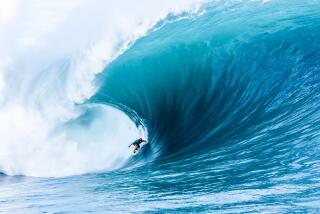‘You, the Machine, the Water and the Weather’
- Share via
Simulating water is perhaps one of the toughest challenges in creating a game. Simulating an ocean was considered next to impossible--until recently.
This holiday, two games are looking to break the water barrier--”Transworld Surf,” published by Infogrames Inc. and developed by Angel Studios, and “Wave Race: Blue Storm,” from Nintendo Software Technology Corp., a division of Nintendo Co.
Part of the problem is the sheer complexity of fluid dynamics, which requires significant computing power to adequately simulate.
Until the latest crop of beefy consoles came along, developers have had to take shortcuts to mimic the real thing, cheats that left players vaguely dissatisfied.
Leveraging the power of new consoles, the creators of “Transworld Surf” on the Xbox and “Wave Race” on GameCube hope to make a splash where others have beached. Claude Comair, 44, talks about how his team applied the Nintendo philosophy of game design to make “Wave Race.”
Question: Describe how you simulated the wave physics.
Answer: We try to strike a balance between real physics and game physics. We have a model we call inverse kinematics. When you have a force, such as the surface making an upward wave, it will lift up the riders. As the riders flex to stay afloat, the movement is traced back to the character. That’s inverse kinematics. We also have forward kinematics. That’s the force that comes from the characters toward the water. Take your arm. You extend your arm. That’s forward kinematics. If someone pulls your arm, that’s inverse kinematics. We take account of both.
So every single wave and wake, every gust of wind affects the character and the game play. Hence, we have an unlimited model. Each time you race the same track, you get a new experience.
Q: How much do weather effects really affect game play?
A: In this game, you really feel rough weather. High winds will give you very large waves that could actually be used as trampolines. You can jump much higher than normal if you have large waves. Rain and fog will affect your visibility. The tide will change, so sometimes you’ll have access to a certain passage and sometimes there will be rocks in your way. It’s very realistic. It will help you forget yourself, so you feel you’re in that storm.
The point of the game is to have you, the machine, the water and the weather--all in one. We try to transport you to that part of the world. In some cases, you may even get seasick. There’s even water splashing on the camera lens.
Q: How is “Wave Race” for the GameCube different from the Nintendo 64 version?
A: The game play is totally different. For example, the previous game had no weather. Before, also, you wouldn’t be affected by someone else’s wake as they race beside you. Now, you create a wake that affects other players. You can also ride behind other players and pick up speed from the void of air behind them. This game is not a port. It’s a true sequel. Players will have many adventures but not the same adventures.
Q: If “Wave Race” were a case study for students of game design, what lessons would it offer?
A: Some games, in order to make it interesting, would give you 700 different guns and 20,000 different bullets. They take all this and mush it together and hope it’s fun because the game has no essence. “Wave Race” is a classic game in that it has an essence. The essence is the water. We have a surface of a water, and we took that concept to its extreme.
Nintendo games are not about being messy and shoving everything into one bucket. They are extremely studied, and they focus on one fun element. It’s a very well-defined element. Our game is an example of this tradition. Our element is the water and taming the water. Take a wonderful movie like “Backdraft.” Fire is the element that you have to conquer. In our game, the wild element is the water. You have to ride it and tame it. Once you have done that, you can take the game to the edge of the world and into the eye of the storm, the ultimate thrill.
Q: You’re also the director and founder of the DigiPen Institute of Technology, which trains students to be game developers. How involved were DigiPen students and faculty in this game?
A: About 90% of the engineers on “Wave Race” came from DigiPen. Some of them are teachers and some are graduates. The majority were graduates. As students, they have worked on many, many games.
We have 340 full-time students, and our graduates are working everywhere, from Electronic Arts to Konami to Sony.
*
Alex Pham covers the video game industry. She can be reached at [email protected].






